Click image for BBB rating
See our Privacy Policy
cool="cool" width="786" height="11237" border="0" cellpadding="0" cellspacing="0" gridx="16" showgridx="showgridx" usegridx="usegridx" gridy="16" showgridy="showgridy" usegridy="usegridy" bgcolor="#99ccff">
|
|
|
 |
|
|
|
|
|
|
Welcome to Spaightwood Galleries, Inc.
120 Main Street, Upton MA 01568-6193
You can follow us on Facebook at http://www.facebook.com/pages/Spaightwood-Galleries-Inc/122951564441757
I blog there regularly and announce special events and special sales.
|
|
|
|
|
Before the Reformation, the subjects most likely to be depicted in religious art included Adam and Eve's fall in the Garden of Eden as modeled by Masaccio, Michelangelo, and Raphael among others. With the Reformation, the meaning of the fall became crucial: how far down did Adam and Eve fall and by what means could they be raised back up again. (Other subjects generated by this event included the fate of Adam and Eve's posterity, including Cain and Abel; the decline of life into sinfulness that led to the flood, with Noah as God's chosen agent to save those who were to be saved; Lot, the one just man permitted to leave Sodom before its destruction; chosen to destroy God's enemies but through his own weakness, forced to destroy himself as well when he pulled the temple of Dagon down upon the Philistines gathered there; Judith, whose faith allows her to save her people from Holofernes and the Assyrians; Susanna, whose innocence proves no defense against the false witness of the elders who try to coerce her into granting them sexual favors, but who is saved when God calls up a child to foil the elders (who stony hearts are rewarded by being crushed by stones for bearing false witness). Of course, the New Testament was of even more relevance to artists of the Renaissance, Reformation, and Counter-Reformation: popular subjects included events from the life of Jesus, images of the Virgin Mary, devotional images of saints commissioned for altar pieces, and devotional works for side chapels in churches or in the homes of the wealthy. With the explosive growth in the production of prints at the beginning of the 16th century, opportunities to create images abounded and the audience for them multiplied: now even those much lower down on the financial tree could own their own art and with the Reformation, doctrinal issues seem to have become central for many commissioning and publishing prints. Prints could depict individuals who were either positive or negative examples and prints could depict biblical histories by showing cycles devoted to significant biblical events like creation, temptation, fall, the life of fallen man, heroes and heroines of the Old and New Testaments, and subjects from the life of Christ, usually focusing on his miracles or his sufferings, and images showing the acts and sufferings of the faithful. In the North, the center of artistic activity in the early part of the century was focused in Nuremberg, where Albrecht Durer and the artists he influenced (such as Hans Sebald Beham, Heinrich Aldegrever, Georg Pencz, Daniel, Hieronymous, and Lambert Hopfer, and others) worked and in the Netherlands, where Lucas van Leyden's works were a starting point for those who came after, like Hendrik Goltzius and Jan Saenredam. As Netherlandish artists started traveling to Italy and returning with a whole new set of ideas about how prints ought to look and work, Mannerism based upon Italian models (especially Raphael, Michelangelo, and Titian) but drawing as well upon the works of Durer and Lucas became the dominant style and the lands that would become Belgium and Holland became the center of the print world. During the mid to late 16th century and the first part of the 17th century, artists and print publishers located in Antwerp (like Cornelis Cort, Jan Sadeler, Phillip Galle, the Wierix brothers, the Collaert brothers) or, after the fall of Antwerp to the Spanish, in other Dutch cities (including artists like Hendrick Goltzius or Rembrandt) produced large bodies of work published in books, in portfolios, and as single sheets for large publishers like Hieronymous Cock, the Plantin-Moretus publishing dynasty, or the great engraver-publishers like Jan Sadeler, Philips Galle, Hendrik Goltzius, and others. Within this large body of images, we have chosen to present several groups as identified above and several overviews. The two sets of prints depicting the heroines of the Old Testament and of the New by Adrien and Hans Collaert and by Carel de Mallery after drawings by Maerten de Vos (see links above) provide an easy introduction to the question of the role of individuals in 16th- and early 17th-century art; the links to specific individuals like Adam and Eve, Noah, Lot and his daughters, Samson and Delilah, Jephthah and his daughter, Judith, Susanna, the Virgin and Jesus, and Mary Magdalene among many others provide extended glimpses of some different kinds of presentations of these key figures suggesting that Renaissance artists and viewers may have been both more complex and more sophisticated in their presentations than they have recently been given credit.
Select Bibliography: W. Th. Kloek et al, Northern Netherlandish Art 1525-1580: Art Before the Iconoclasm (Amsterdam: Rijksmuseum, 1986); H. Diane Russell, Eva / Ave: Women in Renaissance and Baroque Prints (Washington DC: The National Gallery of Art, 1990); Ellen Schultz, ed. Gothic and Renaissance Art in Nuremberg 13000-1550 (NY: Metropolitan Museum of Art, 1986).
|
|
|
|
 |
|
|
Peter van der Borcht II (Malines 1535-1608 Antwerp), Creation (Genesis 1:2). Original engraving, c. 1580. Van der Borcht fled Malines and came to Antwerp during the Spanish Terror; Malines, in particular, suffered a slaughter of Protestants which led van der Borcht to come to Antwerp where he could work with the great publisher Christophe Plantin, both designing images for other artists to engrave and engraving his own works as well. For more on van der Borcht, see James Clifton and Walter S. Melion, Scripture for the Eyes: Bible Illustration in Netherlandish Prints of the Sixteenth Century (NY: Museum of Biblical Art, 2007, pp. 57-63 and 150..Image size: 212x283mm. Price: Please call or email for current pricing information.
|
|
|
 |
|
|
|
Hans Lachner (active Augsburg, c. 1580), The Creation of the Sun and the Moon. Original engraving, c. 1580. A very good impression on laid paper with thread margins. Inscribed on the plate lower left: "Hans Lachner" (lower left) and "IIII" (top, center). Lachner was a painter and engraver about whom too little is known. This is part of a series on the Creation, here showing the Trinity engaged in creating the universe. Another impression of this engraving is part of the Achenbach Foundation for Graphic Arts of the Fine Art Museums of San Francisco and is illustrated on their website along with five other engravings by Lachner from this series. Image size: 230x298mm. Price: Please call or email for current pricing information.
|
|
|
|
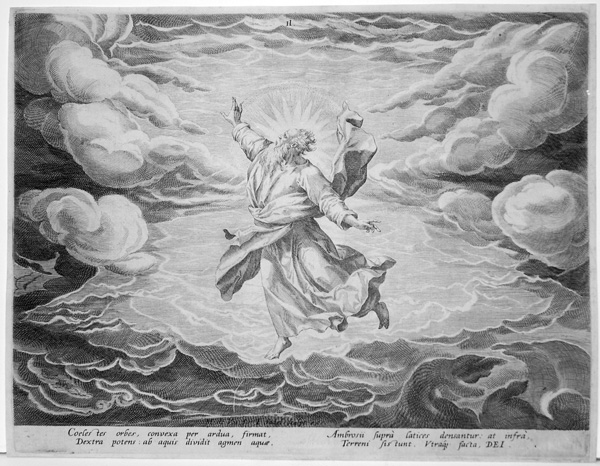 |
|
|
Jan Sadeler (Antwerp, 1550-1600), Creation of the Firmament (TIB 7001: 011 ii/ii). Engraving after Maarten de Vos, c. 1586. A very good impression on laid paper trimmed on or within the plate mark. Inscribed on the plate: "M. de Vos f. I Sadel. sculpt exc" (bottom center ), "II" (upper center). Published in Imago Bonitatis Illivs (1584). Sadeler was a prolific engraver and an important print publisher in the Low Countries during the later 16th century. His brother Raphael set up a printing house in Venice and his nephew Aegidius (Giles) became Imperial Printmaker to Rudolf II. Sadeler worked in Antwerp for Christopher Plantin from 1572-1579 and in Cologne from 1580-84, engraving drawings by Maarten de Vos and Dirk Barendsz. By 1586 he settled in Frankfurt with his family. From 1589 to 1594, he worked at the Court of William V of Bavaria in Munich. In 1595, he left Munich for Verona and Venice, where he died in 1600. Since Plantin and his group of artists and engravers were very much involved with the Protestant sect, the Broeders van Liefde, it is likely that Sadeler's movements are at least partially the consequence of trying to avoid this Spanish reconquest of the Netherlandish provinces during the 1570s and 1580s. Image size: 201x247mm. Price: Please call or email for current pricing information.
|
|
|
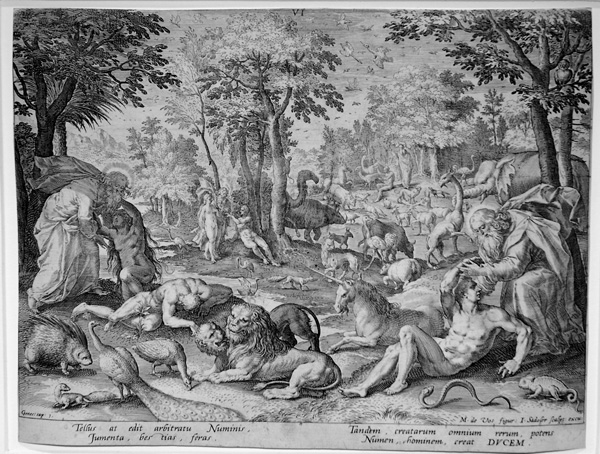 |
|
|
Jan Sadeler (Antwerp, 1550-1600), Creation of the other animals and of man (TIB 7001: 015 i/ii). Engraving after Maarten de Vos, c. 1586. A very good impression on laid paper trimmed on or within the plate mark. Inscribed on the plate: "Genes. cap. j" (bottom left); "M. de Vos figur, I. Sadeler scalpt, excu" (bottom right ), "VI" (upper center). Published in Imago Bonitatis Illivs (1584). The engraving is actually a rectangle; the sides lifted up while I was photographing it. Image size: 191x252mm. Price: Please call or email for current pricing information.
|
|
|
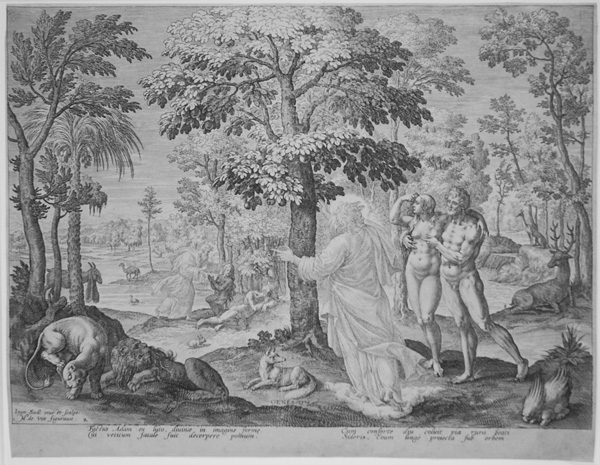 |
|
|
Jan Sadeler (Antwerp, 1550-1600), The Creation of the Man and Woman (TIB 7001: 018 i/ii). Engraving after Maarten de Vos, c. 1583. A very good impression on laid paper trimmed on or within the plate mark. Inscribed on the plate: "Ioan Sadl: inue: et scalps: / M. de Vos figurauit." (lower left); "GENES II" (center). Published in Boni et Mali Scientia / The Knowledge of Good and Evil (1583). Image size: 203x262mm. Price: Please call or email for current pricing information.
|
|
|
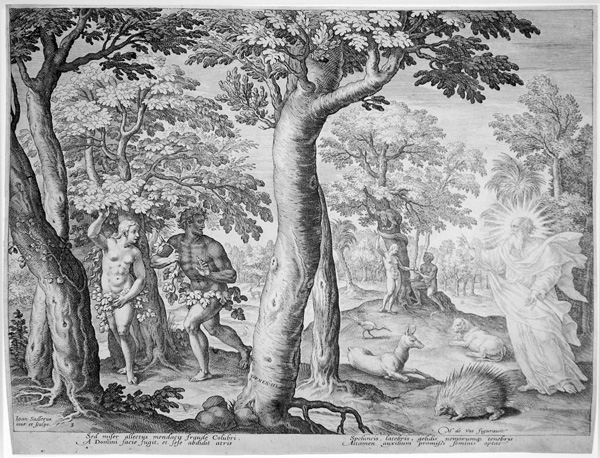 |
|
|
Jan Sadeler (Antwerp, 1550-1600), The Fall (TIB 7001: 019 ii/ii). Engraving after Maarten de Vos, c. 1583. A very good impression on laid paper trimmed on or within the plate mark. Inscribed on the plate: "Ioan Sadlerus / inue: et scalps:" (lower left); M. de Vos figurauit" (lower right); "GENES III" (on tree, center). Published in Boni et Mali Scientia / The Knowledge of Good and Evil (1583). Image size: 204x259mm. Price: Please call or email for current pricing information.
|
|
|
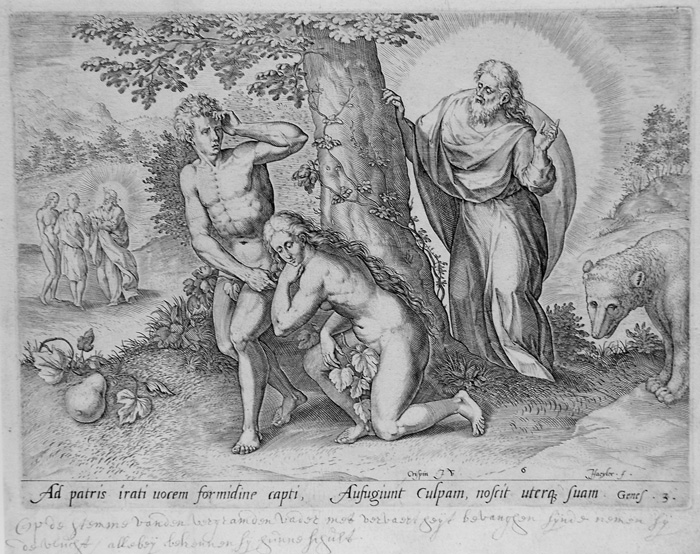 |
|
|
Jan Sadeler (Antwerp, 1550-1600), The Fall (TIB 7001: 006 ii/iii). Engraving after Crispin van den Broeck, 1585. A very good impression on laid paper with margins. Inscribed on the plate: "Crispin JV" (lower center right); "6" (lower right center); "JSaeyler . f " (lower right); "Genes C. 3" (in inscription area). In the background at left, God is clothing the fallen Adam and Eve. The first edition (TIB 7001: 006 ii/iii) from which this image comes was published by Gerard de Jode in the Thesaurus Sacrum Historian Veteris Testamenti / The Sacred History of the Old Testament (Antwerp, 1583); the second edition (see below) replaced the images of God the Father with the Tetragrammaton and inscriptions; it was published in the Theatrum Biblicum / The Theatre of the Bible published by Claes Jan Visscher (Amsterdam, 1643). Image size:197x270mm. Price: Please call or email for current pricing information.
|
|
|
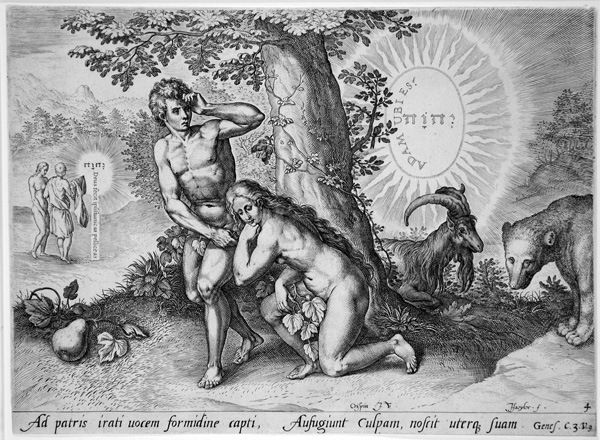 |
|
|
Jan Sadeler (Antwerp, 1550-1600), The Fall (TIB 7001: 006 iii/iii). Engraving after Crispin van den Broeck, 1585. A very good impression on laid paper trimmed on or within the plate mark. Inscribed on the plate: "Crispin -JV-" (lower center right); JSaeyler . f " (lower right); "Genes C. 3 V. g" (in inscription area). In the background at left, God is clothing the fallen Adam and Eve. The first edition (TIB 7001: 006 ii/ii) was published by Gerard de Jode in the Thesaurus Sacrum Historiam Veteris Testamenti / The Sacred History of the Old Testament (Antwerp, 1583) and featured an image of God the Father in the background to the left and the the right of the tree); the second edition (from which this image comes) was published in the Theatrum Biblicum / The Theatre of the Bible published by Claes Jan Visscher (Amsterdam, 1643). This image, of course, would be more appealing to iconoclastic Protestants. Image size: 197x270mm.. Price: Please call or email for current pricing information.
|
|
|
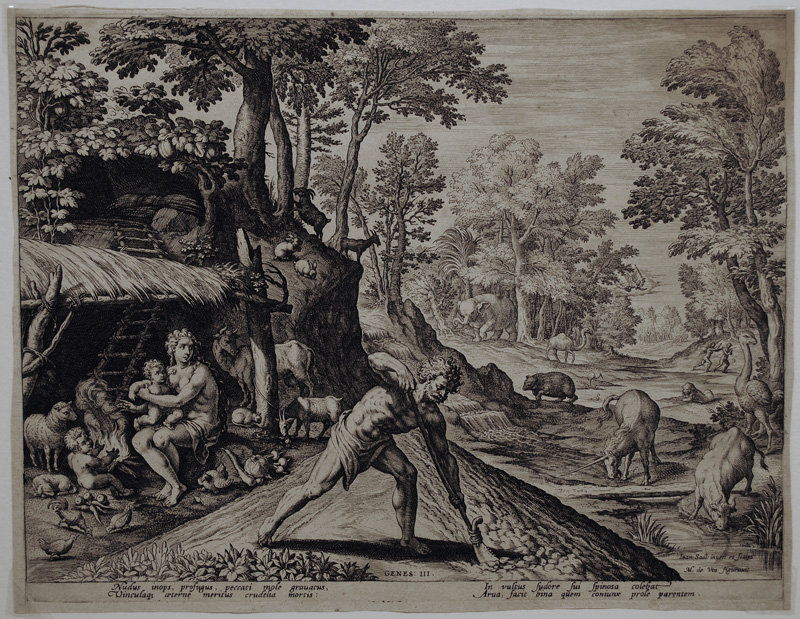 |
|
|
|
Jan Sadeler (Antwerp, 1550-1600), Adam digging in the earth after the Fall (TIB 7001: 020 i/ii; New Holl. M. de Vos 28 i/ii). Engraving after Maarten de Vos, 1583 from The Story of the First Men. A very good impression on laid paper with small margins outside the plate mark. Inscribed on the plate lower right: "JoanSadl inuen: et Scalps / M. de Vos figuravit" ; "Genes III [:23]" (center just above the inscription area). The first edition (New Holl. de Vos 25-36) was dedicated to Francia Maria della Rovere, duke of Urbino and published by Sadeler. Eve hold Abel while Cain warms his hands by a fire. Under the roof of their leant we see a dog, a cat, a sheep, a cow, a chicken, and a goat as well as some vegetables. Keeping Adam company are a unicorn, a cow, a bear, a lion, an elephant, a camel, and an ostrich; on the hill above the leanto, we see a pair of rabbits and more goats.This seeming pastorality, however, is broken top right where we can see two men, one chasing the other (Cain and Abel grown up?) and an angel with a sword flying down to them. Image size: 205x268mm. Price: Please call or email for current pricing information.
|
|
|
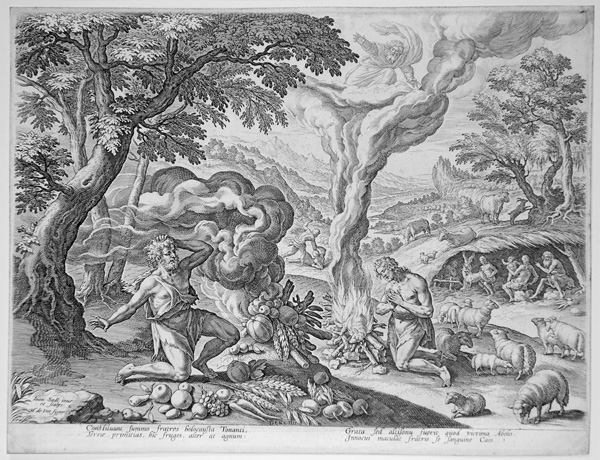 |
|
|
Jan Sadeler (Antwerp, 1550-1600), The Offerings of Cain and Abel (TIB 7001: 022 ii/ii; New Holl. M. de Vos 30 i/ii). Engraving after Maarten de Vos, c. 1583. A very good impression on laid paper trimmed on or within the plate mark; laid down on a support sheet. Inscribed on the plate: "Ioan: Sadl: inue: / et scalps: / M. de Vos figur" (on stone lower left); for the first published edition, the number "6" was added to the stone. Published in The Story of the First Men (1583). Adam and Eve can be seen in the background with their other children. Image size: 205x262mm. Price: Please call or email for current pricing information.
|
|
|
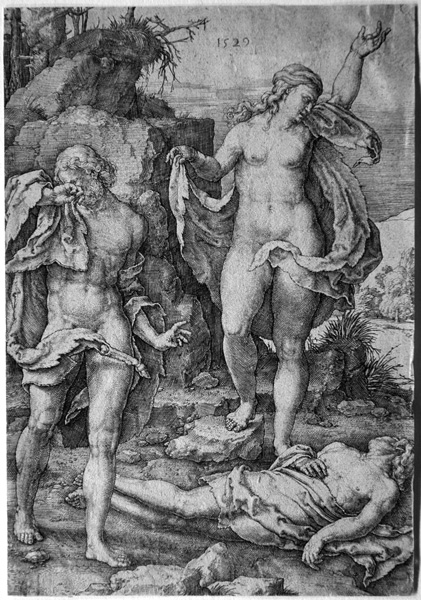 |
|
|
|
Adam & Eve Mourning the Death of Abel (Bartsch 6). Original engraving, 1529. A very good impression trimmed just within the platemark. Signed with the "L" and dated 1529 in the plate. This is the last of a series of six engravings on "The Creation and Fall of Mankind." Image size: 160x110 mm. Price: Please call or email for current pricing information.
|
|
|
|
|
 |
|
|
|
Jan Sadeler (Antwerp, 1550-1600), The curse of Cain (TIB 7001: 023 ii/ii; New Holl. M. de Vos 31 ii/ii). Engraving after Maarten de Vos, c. 1583. A very good impression on laid paper trimmed on or within the plate mark. Inscribed on the plate: " GENES IIII" (center left); "Ioan: Sadl: inue: et scalps" (lower left); "M. de Vos figurauit" (lower right); for the first published edition, the number "7" was added right of center. Published in The Story of the First Men (1583). The text below reminds us of the punishment laid upon Cain for slaying his brother Abel: "And the LORD said unto Cain, Where is Abel thy brother? And he said, I know not: Am I my brother’s keeper? And he said, What hast thou done? the voice of thy brother’s blood crieth unto me from the ground. And now art thou cursed from the earth, which hath opened her mouth to receive thy brother’s blood from thy hand; thou tillest the ground, it shall not henceforth yield unto thee her strength; a fugitive and a vagabond shalt thou be in the earth. And Cain said unto the LORD, My punishment is greater than I can bear. Behold, thou hast driven me out this day from the face of the earth; and from thy face shall I be hid; and I shall be a fugitive and a vagabond in the earth; and it shall come to pass, that every one that findeth me shall slay me. And the LORD said unto him, Therefore whosoever slayeth Cain, vengeance shall be taken on him sevenfold. And the LORD set a mark upon Cain, lest any finding him should kill him. And Cain went out from the presence of the LORD, and dwelt in the land of Nod, on the east of Eden. And Cain knew his wife; and she conceived, and bare Enoch (Gen. 4:9-4:17). Image size: 205x262mm. Price: Please call or email for current pricing information.
|
|
|
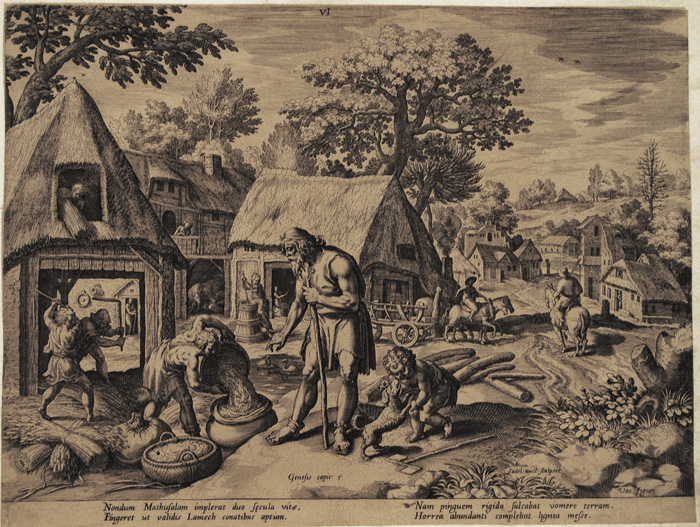 |
|
|
Jan Sadeler (Dutch, 1550-1600), Methuselah and his children (TIB 7001.034, Holl. de Vos 46). Engraving after Maarten de Vos, 1586. One of the many collaborations between Maarten de Vos and Jan Sadeler, here as part of a series on The Story of the Family of Seth (1586). Inscribed at top: "VI"; "Sadel: auct: scalpsit / Vos figur" lower right. The story of the Creation, Fall, and its Consequences may have seemed to offer a way of understanding the religious wars during the period, especially in the Netherlands, where Spanish armies were frequently unleashed upon towns and cities where Protestants could be found and slaughtered. Image size: 208x274mm. Included with the painting below.
|
|
|
 |
|
|
|
|
Willem Buytewech (Rotterdam, 1591/92-1624). Methuselah and his children (see (Jan Sadeler, TIB 7001.34, Holl. 1980 34). Grisaille on wood after an engraving by Jan Sadeler based on a drawing by Maarten de Vos, c. 1612-15. Maria van Berge-Gerbaud's article on Buytewech in the Grove Dictionary of Art, 5: 323-326, stresses his "highly praised versatility," which, she suggests, "emerges not only from his use of different techniques but also from his great range of subjects, especially in his drawings: religious and historical scenes, figures, interiors, scenes of everyday life, allegories, groups, architectural features, landscapes, designs for book illustrations, etc. Only a few works are dated, making it difficult to establish a chronological and stylistic development, especially as they were produced over such a short period. Thus his oeuvre is normally treated chronologically" (p. 323). The most important critical study is Willem Buytewech 1591-1624 (Paris: Institut Néerlandais, 1974), the catalogue of a joint exhibition at the Museum Boysmans-van Beuningen in Rotterdam and the Institut Néerlandais in Paris, with an introductory essay by E. Haverkamp Begemann. Although our piece is not done in one of his later styles, Haverkamp Begemann includes a 1615 drawing very reminiscent of Goltzius or Matham (item 24, plate 46) and notes in his commentary that familiarity with the works of 16th-century Northern European artists could have been expected at that time (e.g., Rudolph II’s fixation on Durer, the Lucas van Leyden revival in Goltzius’ circle). Given that the Wierix brothers made engravings after Durer prints for their Master’s pieces, it seems possible that Buytewech made this for a similar purpose (which would suggest a date of c. 1612). Another possibility is that given the sheer number of drawings by Maarten de Vos (1531-1603) made for engravers and print publishers (c. 1600 engravings were made based upon his drawings), Buytewech could have been familiar with them in general and this one in particular and may have chosen it to advertise his familiarity with the traditions of late 16th-century Netherlandish art and his skill at working in different media; it could also have been a commission for a young artist just beginning a career that might have been useful from a financial point of view as well as showing his ability to meet a patron’s needs. If Buytewech was born in 1591, he was about 24-25 years old when he did the Goltzius-style “Homme en costume de fantasie”; if he was admitted master in 1612 (in Haarlem, where he had been living since 1611), he was then 21-22 and perhaps feeling a need to show his mastery of all of the recent Netherlandish styles. Buytewech's drawings were interesting enough that some of them were engraved by others (including C. van Kittensteyn, G. van Schneydel, and Jan II van de Velde) and collected by others including Rembrandt. Interestingly, his drawings make much higher prices at auction than his paintings (Christie's NY and London records 4 sales between 2002 and 2006 ranging from Please call or email for current pricing information (a small study of a man in the manner of Goltzius or Matham [Haverkamp Begemann plate 46]) to Please call or email for current pricing information (the two in the middle sold for Please call or email for current pricing information and Please call or email for current pricing information), all of which were in one of his later styles and all of which were much smaller than ours. Condition: very good save for a small chip lower edge center; the wood has warped and it has been mounted on a wood cradle to prevent further warping and to stabilize it. Image size: 398x615mm (15-3/4x24-3/16 inches). Price: Please call or email for current pricing information.
|
|
|
|
|
 |
|
|
|
The work is signed with Buytewich's monogram, which is shown extensively in the works reproduced in Willem Buytewech 1591-1624, including on the illustration on the front cover.
|
|
Spaightwood Galleries, Inc.
To purchase, call us at 1-800-809-3343 (1-508-529-2511 in Upton MA & vicinity) or send an email to spaightwood@gmail.com.
We accept AmericanExpress, DiscoverCard, MasterCard, and Visa.
We also accept wire transfers and paypal.
For directions and visiting information, please call. We are, of course, always available over the web and by telephone (see above for contact information). Click the following for links to past shows and artists. For a visual tour of the gallery, please click here. For information about Andy Weiner and Sonja Hansard-Weiner, please click here. For a list of special offers currently available, see Specials.
All works are sold with an unconditional guarantee of authenticity (as described in our website listing).
Copyright 2004-2017, Spaightwood Galleries, Inc.
Go back to the top of this page.
Visiting hours: Saturday 10:00 am to 5:00 pm and Sunday noon to 6:00 pm and other times by arrangement.
Please call to confirm your visit. Browsers and guests are welcome.
|
|
|
|
|
|
|
|
|
|
|
|
|
|
|
|
|
|
|
|
|
|
|
|
|
|
|
|
|
|
|
|
|
|
|
|














